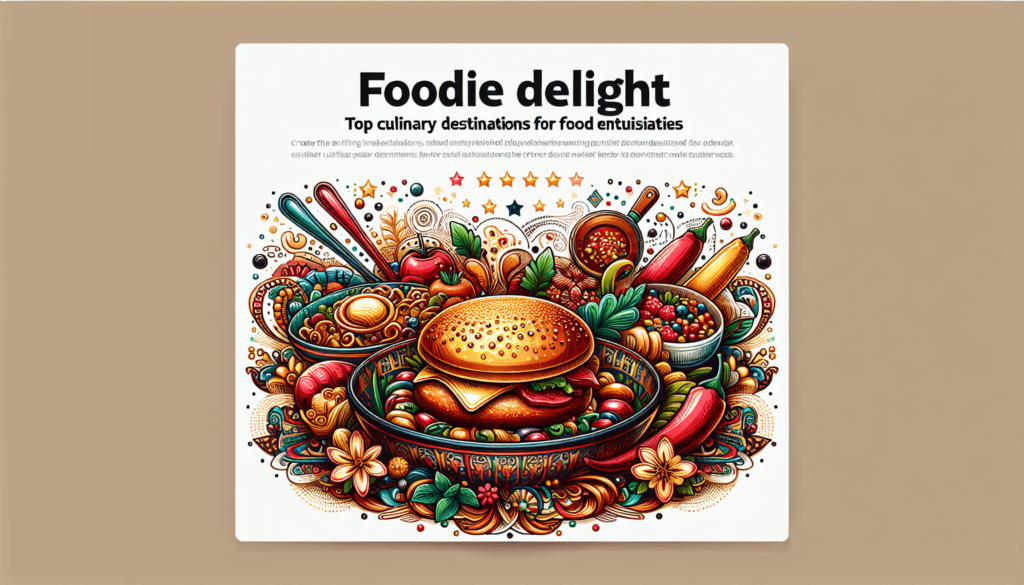Imagine the delight of wandering through bustling street markets in Bangkok, savoring the rich flavors of Pad Thai, or indulging in freshly baked pastries and cheese in a quaint Parisian café. “Foodie Delight: Top Culinary Destinations for Food Enthusiasts” whisks you away on a gastronomic journey, exploring the world’s most renowned culinary locales, steeped in history and tradition.
Whether it’s the spicy allure of Indian curries in Hyderabad, the vibrant, fresh sushi in Tokyo’s Tsukiji Market, or the hearty, comforting pasta dishes in a rustic Italian trattoria, this article unveils destinations that promise unforgettable flavor experiences. You’ll immerse yourself in the cultural and historical contexts that have shaped these culinary havens while appreciating current trends and innovations that keep them at the forefront of the global food scene. Dive into a feast for the senses, where each paragraph transports you to a new corner of the world, celebrating the diverse and rich tapestry of global cuisine.
Have you ever found yourself daydreaming about an adventure centered entirely around the delightful flavors of the world? If so, you’re in for a treat—literally and metaphorically! Welcome to a journey that celebrates the best culinary destinations globally, designed specifically for you, the food enthusiast, who loves to explore the world one bite at a time.
Table of Contents
Overview
Food tourism has witnessed a major upswing, transforming the way we perceive travel. Now, more than ever, people embark on trips not just to see landmarks but to savor the local cuisines, wine, and culinary traditions. This phenomenon reflects the rich tapestry of global cultures and paves the way for gastronomic delights that engage all your senses.
Thesis Statement
In today’s modern travel era, “Foodie Delight: Top Culinary Destinations for Food Enthusiasts” aims to guide you through a curated list of cities and regions celebrated for their rich culinary heritage, innovative food scenes, and immersive gastronomic experiences. These destinations promise to fulfill your wildest culinary fantasies and make for unforgettable travel tales.
Historical Context
Before diving into the contemporary food scene, let’s take a step back and appreciate the historical context that shapes these culinary meccas. Each culture’s cuisine is deeply rooted in its history, influenced by geographical factors, historical events, and socio-economic conditions. For instance, the blend of spices in Indian cuisine tells a tale of ancient trade routes, while the rich, hearty flavors of French cuisine echo the sophistication of its royal courts.
The Spice Trade: India
India’s legendary status as a spice hub dates back to the early centuries when spices were considered as valuable as gold. The Vasco da Gama discovery route marked a significant turn, bringing Indian spices to European kitchens. This historical exchange established the foundation for India’s diverse and flavorful culinary scene that continues to enchant food enthusiasts today.
The French Court Influence
French cuisine’s refined techniques and elaborate presentations owe much to its royal history. During the reign of Louis XIV, the French court’s emphasis on luxurious banquets and premium ingredients set the precedent for the classical French culinary arts we revere today, making France a perpetual hotspot for gourmet adventures.

Current Trends
Fast forward to contemporary times, and the world of food tourism is buzzing more than ever. Two significant trends are reshaping how we seek culinary experiences: the farm-to-table movement and the rise of fusion cuisine.
The Farm-to-Table Movement
This trend emphasizes sourcing ingredients directly from local farms to ensure freshness and sustainability. From Michelin-starred restaurants to quaint local eateries, the farm-to-table approach has gained traction worldwide. It’s not just a dining choice but a movement toward sustainable and responsible eating.
Rise of Fusion Cuisine
Fusion cuisine marries elements from various culinary traditions to create innovative and often surprising dishes. Think sushi burritos or Korean tacos! This trend reflects our global interconnectedness, offering diverse and bold flavors that appeal to adventurous palates.
Key Concepts and Definitions
To ensure you get the most out of this exploration, let’s define a few key concepts likely to pop up throughout our culinary journey.
Gastronomy
Gastronomy refers to the study of the relationship between food and culture. It’s more than just cooking; it’s an art form that includes the preparation, presentation, and appreciation of good food.
Street Food
Street food encompasses a variety of ready-to-eat meals and snacks usually sold by vendors and hawkers in public places. It offers a lens into the everyday culinary habits and local flavors.
Detailed Exploration
Now, let’s dive deeper into specific destinations, each offering a unique and tantalizing culinary landscape.
Japan: The Land of the Rising Sun and the Ultimate Sushi Experience
Japan’s cuisine, known for its precision, aesthetics, and balance, extends beyond sushi bars and ramen joints. Tokyo alone boasts more Michelin-starred restaurants than any other city in the world. Visit Tsukiji Fish Market in Tokyo for the freshest sushi you’ll ever taste. Kyoto offers Kaiseki dining—a multi-course experience showcasing seasonal ingredients and traditional techniques. For street food enthusiasts, Osaka’s Dotonbori district serves up Takoyaki (octopus balls) and Okonomiyaki (savory pancakes) that epitomize Japanese comfort food.
Italy: A Romantic Culinary Sojourn
Who can resist the allure of Italy with its mouth-watering pasta, pizza, and gelato? Each Italian region boasts its culinary pride—from the wine and cheese of Tuscany to Sicily’s seafood and street food. In Bologna, take time to savor Tagliatelle al Ragù. In Naples, birthplace of pizza, a slice of true Neapolitan Margherita is a must. Meanwhile, Venice’s Cicchetti bars offer small plates that are perfect for sampling a variety of local treats.
Mexico: A Fiesta of Flavors
Mexican cuisine, recognized by UNESCO as an Intangible Cultural Heritage, is a fiesta of flavors, colors, and textures. Head to Mexico City to explore its vibrant street food scene, offering everything from Tacos al Pastor to Churros. Oaxaca, known as the “Land of the Seven Moles,” provides an in-depth exploration of complex, mouth-watering sauces. Don’t forget to try Yucatecan cuisine in the city of Mérida, where dishes like Cochinita Pibil exemplify tradition and flavor.
Thailand: A Symphony of Spices and Aromatics
Thailand, with its national dish Pad Thai and globally adored Tom Yum soup, promises an unforgettable culinary journey. Bangkok’s street food scene is legendary, with vendors serving aromatic dishes like Som Tum (green papaya salad) and Mango Sticky Rice. In Chiang Mai, partake in a Northern Thai Khantoke dinner for a traditional communal meal experience. Don’t miss the floating markets where you can sample a variety of authentic Thai foods right from the boat.
France: The Pinnacle of Fine Dining
When you think of culinary sophistication, France inevitably comes to mind. Indulge in Paris’s chic bistros and high-end Michelin-starred restaurants offering Coq au Vin and Crème Brûlée. Venture to Lyon, often dubbed the world’s culinary capital, to taste traditional Bouchon fare. The Champagne region offers rich indulgence via its namesake bubbly, paired perfectly with fine cheeses and charcuterie.

Example 1: The Rise of Noma – A Case Study in New Nordic Cuisine
Noma, located in Copenhagen, Denmark, has redefined what it means to be a culinary destination. Spearheaded by Chef René Redzepi, Noma has been named the world’s best restaurant multiple times, focusing on local and seasonal ingredients, foraging, and fermentation. This form of New Nordic Cuisine highlights simplicity, purity, and freshness while rewriting the rules of gastronomy.
Data Point: The Impact
According to a study by VisitDenmark, the presence of top-tier restaurants like Noma has increased culinary tourism to Denmark by 22% over the last decade. Travelers come for the food and stay for the cultural experience, showing the profound impact a single restaurant can have on a nation’s tourism sector.
Example 2: The Phenomenon of Street Food Markets – Borough Market in London
Borough Market in London offers a testament to the city’s diverse culinary landscape. From fresh seafood to artisanal cheeses and international delights like Paella and Middle Eastern Falafel, Borough Market is a haven for food lovers. This bustling market represents the resurgence of interest in artisanal and street food, providing not just meals but an engaging sensory experience.
Data Point: Visitor Statistics
Reports show that Borough Market attracts over 4.5 million visitors annually, both locals and tourists. This underscores the importance of integrating local and global culinary elements to create a magnet for food enthusiasts.
Comparison of Different Perspectives
Different culinary hubs highlight varying philosophies and approaches to food, shaped by their cultural and historical contexts.
For example, Japanese cuisine focuses on purity and simplicity, emphasizing the quality of ingredients through minimal seasoning. In contrast, Mexican cuisine is vibrant and layered, building depth through complex mixtures of spices and preparation techniques. While both offer rich, satisfying experiences, they cater to different palates and expectations.
Impact Assessment
These perspectives profoundly impact not just the culinary landscape but also the socio-economic aspects of these regions. Culinary tourism generates substantial revenue, fosters cultural exchange, and puts lesser-known places on the global map. Regions with a rich food culture gain more visibility and attract a discerning audience seeking immersive, authentic experiences.
Future Directions and Implications
Predictions
Given the current trends, one might predict the future of culinary tourism will lean even more heavily towards sustainability, innovation, and authenticity. We can expect an uptick in agritourism—the blending of agriculture with tourism—where travelers participate in farming activities, farm-stays, and dining experiences that directly source from the farms.
Implications
These future trends are poised to boost the local economy, promote sustainable farming practices, and foster a deeper understanding of global cultures. This shift towards sustainable and authentic experiences will likely have a significant impact on how societies view food—from a mere necessity to a deeply enriching part of life, culture, and ecology.
Conclusion
Recap
We’ve journeyed through some of the most exciting culinary destinations, delving into their historical contexts, current trends, key concepts, and future directions. Each destination offers a unique flavor profile and dining experience, whether it’s the delicate balance of Japanese cuisine, the robust flavors of Italian dishes, or the vibrant, spicy world of Mexican street food.
Final Thought
So, where will your next culinary adventure take you? Perhaps the delicate artistry of Tokyo’s sushi bars or the bustling, aromatic markets of Bangkok will call your name. The world is a vast buffet awaiting your exploration.
Engagement
We’d love to hear about your favorite culinary destinations or dream food adventure spots! Share your thoughts, experiences, or questions in the comments below. And if you enjoyed this gastronomic guide, don’t forget to share it with fellow food enthusiasts.
Credible Sources
- “The History of Indian Spices”, The Spice Journal
- “The French Court and Its Culinary Influence”, Culinary History Magazine
- “The Impact of Noma on Denmark’s Tourism”, VisitDenmark Annual Reports
- “Borough Market Visitor Statistics”, London Markets Association
Indulging in Epicurean Escapes: A Gastronomic Journey Abroad
